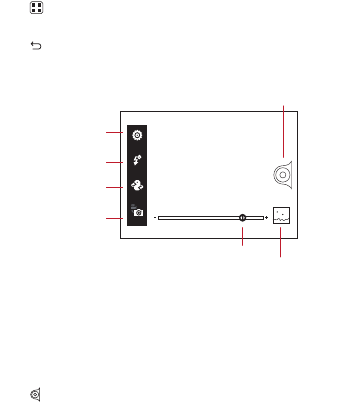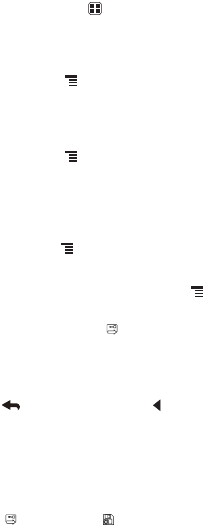Huawei Technologies U8680 HSPA/UMTS/GPRS/GSM/EDGE Mobile Phone with BT User Manual 3
Huawei Technologies Co.,Ltd HSPA/UMTS/GPRS/GSM/EDGE Mobile Phone with BT 3
Contents
User Manual - 3

39
access.
Touch to open the browser options menu and perform one of the following
operations:
•
New window
: Touch to open a new window.
•
Bookmarks
: Touch to display bookmarks.
•
Windows
: Touch to view thumbnails of open browser windows. You can switch to
another browser window or open a new one on this screen.
•
Refresh
: Touch to refresh the current webpage.
•
Forward
: Touch to browse the next web page.
•
More
: Touch to open other menus and perform operations such as searching,
selecting text, downloading, or setting options.
7.4.2 Opening a Webpage
1. In a browser window, touch the URL field at the top of the screen.
2. Use the keyboard to enter a webpage address. You can touch to enter the
web page address by voice.
3. As you enter the address, matching webpage addresses will appear on the screen.
If you see the address you want, touch it and go directly to that webpage or
complete entering your desired webpage.
7.4.3 Setting a Home Page
1. In a browser window, touch .
2. Touch
More
>
Settings
>
Set home page
.
3. Enter the address of the desired home page, and then touch
OK
.
7.4.4 Managing Bookmarks
You can store as many bookmarks as you want on your mobile phone.
Adding a Bookmark
1. In a browser window, go to the webpage you want to save as a bookmark.
2. Touch , and then touch
Bookmarks
>
Add
.
3. Edit the bookmark name and then touch
OK
.

40
Opening a Bookmark
1. In a browser window, touch , and then touch
Bookmarks
.
On the
Bookmarks
screen, touch the
History
tab to view the pages you have
visited, or touch the
Most visited
tab to view the pages you have visited most
frequently.
2. Touch the bookmark of the website you want to open.
7.4.5 Customizing Browser Settings
Customize the browser to suit your browsing style. Use
Browser
to set page content,
privacy, and security preferences. In a browser window, touch , and then touch
More
>
Settings
.
7.5 Bluetooth
Your mobile phone has Bluetooth, which allows you to create a wireless connection
with other Bluetooth devices so you can share files with your friends, talk hands-free
with a Bluetooth headset, or even transfer photos from your phone to your PC.
If you are using Bluetooth, remember to stay within 10 meters (33 feet) of the other
Bluetooth devices to which you want to connect. Be aware that obstacles like walls or
other electronic equipment may interfere with your Bluetooth connection.
7.5.1 Turning On Bluetooth
1. Touch >
Settings
.
2. Touch
Wireless & networks
, and then select the
Bluetooth
check box to turn on
Bluetooth. When Bluetooth is turned on, the Bluetooth icon appears in the
notification bar.
3. Touch
Bluetooth settings
, and then select the
Discoverable
to make your
mobile phone visible to other Bluetooth devices.
7.5.2 Pairing with and Connecting to a Bluetooth Device
Your mobile Bluetooth lets you do the following:
• Hands Free Profile (HFP): allows you to use a hands-free Bluetooth device.
• Headset Profile (HSP): allows you to use a mono Bluetooth headset.

41
• Object Push Profile (OPP): allows you to transfer files over a Bluetooth connection.
• Advanced Audio Distribution Profile (A2DP): allows you to use a stereo Bluetooth
headset.
• A/V Remote Control Profile (AVRCP): allows you to control audio playing using a
Bluetooth headset remotely.
Before you use Bluetooth, pair your mobile phone with another Bluetooth device as
follows:
1. Ensure that the Bluetooth function on your mobile phone is enabled.
2. On the Home screen, touch >
Settings
>
Wireless & networks
>
Bluetooth
settings
. Your mobile phone will then scan for Bluetooth devices in range.
3. Touch the device you want to pair your mobile phone with.
4. If required, enter the pairing password to complete the connection.
7.5.3 Sending Files via Bluetooth
With Bluetooth, you can share pictures, videos, or music files with your family and
friends. To send files via Bluetooth:
1. Touch and hold the file to be sent in your mobile phone or SD card. The active
options menu is displayed.
2. Touch
Share
, then
Bluetooth
to select a paired device.
7.5.4 Disconnecting from or Unpairing with a Bluetooth Device
1. Touch >
Settings
>
Wireless & networks
>
Bluetooth settings
.
2. Navigate to the
Bluetooth devices
section, and then touch and hold the device to
which you are connected.
3. Touch
Unpair
to disconnect from the device.
8 Entertainment
In addition to being a communication device and personal assistant, your mobile
phone also provides you with a multitude of entertainment possibilities. You can take
photos, create videos and audio clips, and download and listen to music.

42
8.1 Taking Photos and Recording Videos
The camera is a combination of camera and camcorder that you can use to shoot and
share pictures and videos.
8.1.1 Opening Your Camera
• Touch >
Camera
to open the camera. The camera opens in landscape
mode, ready to take a picture or record a video.
• Touch to close the camera.
Capture Screen
8.1.2 Taking a Photo
1. Open your camera application and switch it to camera mode.
2. If necessary, change the camera settings. The preview changes as you change
the settings.
3. Frame your photo within the photo capture screen.
4. Touch to take your photo.
Photos taken are displayed for a moment. You can take another photo or review your
photos.
3
5
Touch to customize
the camera settings.
Thumbnail of the last photo. Touch to preview the photos or videos.
Touch to take a photo.
Settings
Flash
Back
Camera
Touch to switch between
camera and video modes.
In camera mode, slide left or right the zoom bar to zoom in or out.
Touch to switch
the camera light
on or off.
Touch to switch between
front camera and
back camera.

43
8.1.3 Viewing Your Photos
1. After taking a photo, a thumbnail of the photo you have just taken is shown in the
lower right corner of the capture screen. Touch the thumbnail to view it.
2. Touch the onscreen button to do any of the following:
• Touch
Share
to share the photo with others.
• Touch
Delete
to delete the photo.
• Touch
More
>
Set as
to set the photo as a contact icon or the wallpaper.
8.1.4 Recording a Video
1. Open the camera application, and then switch it to video mode.
2. If necessary, change the video settings.
3. Frame the scene with which you want to start your video.
4. Touch to start recording a video.
5. Touch to stop recording.
8.1.5 Viewing Your Videos
1. After recording a video, a thumbnail of the video you have just recorded is shown in
the lower right corner of the capture screen. Touch the thumbnail to view it.
2. Touch the onscreen buttons to do any of the following:
• Touch
Share
to share the video with others.
• Touch
Delete
to delete the video.
On the video playback screen, touch the controls to fast-forward or rewind or to
play or pause the video.
3. If you want to view more videos, flick your finger left or right across the screen.
8.2 Using the Gallery
Your
Gallery
application can automatically search for pictures and videos on your
mobile phone and microSD card. Use
Gallery
to sort photos and videos into folders,
view and edit pictures, watch videos, and set a picture as wallpaper or as a photo for
a contact.

44
8.2.1 Opening the Gallery
On the Home screen, touch >
Gallery
.
The
Gallery
application categorizes your pictures and videos by storage location and
displays these files in folders. Touch a folder to view the pictures or videos inside.
8.2.2 Viewing a Picture
1. In
Gallery
, touch the folder that contains the pictures you want to view.
2. Touch the picture to view it in full-screen mode.
3. Touch the screen. Then the zoom panel appears. You can zoom in or zoom out on
the picture.
The picture viewer supports the automatic rotation function. When you rotate
your mobile phone, the picture adjusts itself to the rotation.
8.2.3 Rotating a Picture
1. When viewing a picture, touch to display the operations panel.
2. Touch
More
.
3. Select either
Rotate Left
or
Rotate Right
. The picture is saved with the new
orientation.
8.2.4 Cropping a Picture
1. When viewing a picture, touch to display the operation panel, and then touch
More
>
Crop
.
2. Use the cropping tool to select the portion of the picture to crop.
• Drag from the inside of the cropping tool to move it.
• Drag an edge of the cropping tool to resize the image.
• Drag a corner of the cropping tool to resize the image without changing its
length to width ratio.
3. Touch
Save
to save the cropped picture. Touch
Discard
to discard the changes.

45
8.3 Enjoying Music
Before you using music player, you must copy music files from your computer to the
microSD card.
Once you have done this, the player will search for music on the microSD card. After
the search is complete, you will be able to view all available music files in the music
library.
8.3.1 Copying Music to the microSD Card
1. Connect the phone to your computer with a USB cable and mount the microSD
card.
2. On the PC, navigate to the USB drive and open it.
3. Create a folder in the root directory of the microSD card (for example,
Music
).
4. Copy the music from your computer to the folder you have created.
5. After copying music, unmount or eject the drive as required by your PC’s operating
system to safely remove the mobile phone.
6. Disconnect the mobile phone from the PC.
8.3.2 Opening the Media Library
Touch >
Music
to display the media library.
The
Music
application organizes your music files by storage location. It contains six
tabs:
RECENT
,
ARTISTS
,
ALBUMS
,
SONGS
,
PLAYLISTS
and
GENRES
.
8.3.3 Playing Music
1. Touch a category on the music library screen.
2. Touch the song you want to play.
When you are listening to music, touch , to use another application. Your
music continues to play. To return to the music controls, open the notification
panel and then touch the song.
8.3.4 Adding Music to a Playlist
1. Touch a category on the music library screen.
2. In the list that appears, select the song you want to add to the playlist.

46
3. Touch and hold the song, and then touch
Add to playlist
in the options menu.
• Touch an existing playlist to add the song to an existing playlist.
• Touch
New playlist
to create a playlist and add the song to it.
8.3.5 Playing a Playlist
1. Touch the
Playlists
tab on the music library screen.
2. Touch and hold the playlist you want to play.
3. Touch
Play
to play the playlist.
8.4 Listening to the FM Radio
The FM radio lets you listen to FM radio programs on your mobile phone. Since the
FM radio uses the provided wired stereo headset as its antenna, before opening the
application, connect the headset to your phone’s the audio jack.
8.4.1 Opening the FM Radio
1. On the Home screen, touch >
FM Radio
to open the application.
2. The first time you open FM radio, touch
Auto tuning
, which automatically scans for
available FM channels, saves them as presets, and plays the first FM channel
found.
8.4.2 Tuning the FM Radio
Open the
FM Radio
application, and then do the following:
• Touch or to tune the radio to the previous or next channel.
• Slide the knob left or right to perform precision tuning. When a channel is found,
touch , then
Save channel
. Enter the channel name, touch
OK
, and then
select an empty channel to save the new channel to the channel list.
• Touch >
Auto tuning
to scan automatically for available FM channels.
9 Google Services
Availability of Google applications, services, and features may vary according to

47
your country or carrier. Please follow local laws and regulations to use them.
When you turn on your mobile phone for the first time, touch a Google services such
as
Talk
,
Gmail
, or
Play Store
, and you will be prompted to sign in to your Google
account.
Ensure that your mobile phone has an active data connection (4G/Wi-Fi) before
you sign in to your Google account.
If you already have a Google account, touch
Sign in
and enter your username and
password.
9.1 Creating a Google Account
If you do not have a Google account, you can create one:
1. After reading the setup information, touch
Next
.
2. Touch
Create
.
3. Enter the first name, last name, and user name for your Google account, and then
touch
Next
. The mobile phone will connect to a Google server to check whether the
username is available. If the username you entered is already in use, you will be
prompted to choose another one or select one from a list.
4. Enter and confirm your Google account password.
5. Select a security question from the drop-down menu, and then enter the answer.
6. Touch
Create
.
7. When the
Google Terms of Service
screen appears, touch
I agree, Next
.
8. Enter the characters that appear on the screen, and then touch
Next
.
To use another Google account, go to the
Accounts & sync settings
screen,
and touch
Add account
to select which type of accounts you want to add.
9.2 Gmail
Gmail
is Google’s web-based email service. When you first set up your phone, you
may have configured it to use an existing
Gmail
account or create a new account.
The first time you open the
Gmail
application on your phone, your
Inbox
will contain
the messages from your
Gmail
web account.

48
9.2.1 Opening Gmail
On the Home screen, touch >
Gmail
. The
Inbox
mail list appears. Any emails
you decide to keep on your mobile phone will go to your
Inbox
folder.
9.2.2 Switching Between Accounts
1. In the mail list, touch , and then touch
Accounts
.
2. Touch the account that contains the email you want to read.
9.2.3 Creating and Sending an Email
1. In the mail list, touch , and then touch
Compose
.
2. Enter the message recipient’s email address in the
To
field. If you are sending the
email to several recipients, separate the email addresses with commas. You can
add as many message recipients as you want.
If you want to send a copy (Cc) or a blind copy (Bcc) of the email to other
recipients, touch , and then touch
Add Cc/Bcc
.
3. Enter the email subject and write your email.
If you want to add a picture attachment, touch , and then touch
Attach
to
select the picture you want to attach.
4. After writing your email, touch .
9.2.4 Replying to or Forwarding an Email
1. In the mail list, touch the email that you want to reply to or forward.
2. Touch to reply. You can also touch , and then touch
Reply
,
Reply all
, or
Forward
.
3. Do one of the following:
• If you selected
Reply
or
Reply all
, enter your message.
• If you selected
Forward
, specify the message recipients and add any
additional text you want to include in the forwarded message.
4. Touch to send, or touch to save as a draft.

49
9.2.5 Searching for an Email
1. In the mail list, touch , and then touch
Search
.
2. Enter the search keywords in the box, and then touch .
9.2.6 Customizing Your Gmail Settings
In the mail list, touch , and then touch
More
>
Settings
to customizing your
Gmail
.
9.3 Talk
Talk
is Google’s instant messaging service. You can use it to communicate in real
time with other people using
Talk
on a phone or on the web.
9.3.1 Opening Talk
On the Home screen, touch >
Talk
to open the application.
Your
Talk
account is based on the Google account you set up with your mobile
phone.
9.3.2 Adding a Friend
1. In the friends list, touch , and then touch
Add friend
.
2. Enter the Gmail address of the friend you want to add.
3. Touch
Send invitation
.
9.3.3 Accepting an Invitation
1. If you have invited anyone to chat or if someone else has invited you to chat, this
information will appear in the friends list.
2. Touch a pending invitation, and then touch
Accept
.
9.3.4 Starting a Chat
1. In the friends list, touch a friend's name in the friends list.
2. Use the onscreen keyboard to enter text and chat with your friend.
3. After entering your message, touch
Send
.

50
9.3.5 Setting Notifications for New Instant Messages
Whenever you receive an instant message, your mobile phone can play a sound,
vibrate, or display an icon. To set up one of these handy notifications, start in the
friends list, and then touch . Then touch
Settings
. Now choose from one of the
following:
9.3.6 Signing out of Talk
On the friends list screen, touch , and then touch
Sign out
to quit
Talk
.
9.4 Maps
Maps
lets you find your current location, view real-time traffic conditions (depending
on availability in your locale), and get detailed directions to various destinations. You
can view satellite images, traffic maps, or other kinds of maps of your current or other
locations.
9.4.1 Enabling the Location Service
Before you open
Maps
to find your location or search for places of interest, you must
enable the location service.
1. On the Home screen, touch >
Settings
.
2. Touch
Location & security
.
3. In the
My Location
section, select the
Use wireless networks
check box, the
Use
GPS satellites
check box, or both.
Notifications
Touch to choose whether you receive a notification on the
notification bar when you receive an instant message.
Ringtone
Touch to choose the ringtone used for a new instant
message. You will hear a short sample of the ringtone when
you select it. To turn the ringtone off, select
Silent
.
Vibrate
Touch to choose whether your mobile phone vibrates when
you receive a new instant message.

51
9.4.2 Opening Maps
On the Home screen, touch >
Maps
to open the application.
9.4.3 Searching for Places of Interest
1. On the map, touch , and then touch
Search
.
2. Enter the place you want to search for in the search box, and then touch the Search
icon.
3. Your search results will then be displayed. Touch a place you are interested in and
the application will show where it is on the map.
9.4.4 Getting Directions
1. While viewing a map, touch , and then touch
Directions
.
2. Enter the starting point in the first text box, and then enter your destination in the
second text box.
3. Touch the icon for car, public transit, or walking directions.
4. Touch
Get directions
. Your directions will appear on the map.
5. When you finish viewing or following the directions, touch , and then touch
Clear Map
to reset the map.
9.5 YouTube
YouTube
is Google’s free online video streaming service for watching, searching for,
and uploading videos.
9.5.1 Opening YouTube
On the Home screen, touch >
YouTube
. You will then see the YouTube screen.
9.5.2 Searching for a Video
1. On the
YouTube
screen, touch , and then touch
Search
.
2. Enter a search keyword, and then touch the Search icon.
3. You will see a number of search results displayed below the notification bar. Scroll
through the results and touch a video to watch it.

52
9.5.3 Sharing a Video
From the video list on the
YouTube
screen, select a video clip and touch .
9.6 Play Store
Android Market provides direct access to applications and games which you can
download and install on your phone.
9.6.1 Opening Play Store
1. On the Home screen, touch >
Play Store
.
2. When you open
Play Store
for the first time, the
Google Play Terms of Service
window will appear. Touch
Accept
to continue.
9.6.2 Installing an Application
1. In the
Play Store
, select a category, and then touch the application you want to
download. On the application details screen, you can view more information about
the selected application, such as its cost, overall rating, user comments, and similar
applications in which you might be interested. You can also scroll down to view
information about the application developer, including other information from the
same developer and a link to the developer's website. In addition, you can send the
developer an email.
2. To install the application, touch
Download
(if it is free) or touch the button with its
price (if it is not free), and confirm your download or purchase.
3. To check the progress of a download, open the notification panel. Most applications
are installed within seconds. To stop an application from downloading, touch the
cross (×).
If you want to install a non-Market application, touch >
Settings
>
Applications
, and then select the
Unknown sources
check box to allow
installation of the non-Market application.

53
9.6.3 Uninstalling an Application
1. On the
Play Store
screen, touch >
My Apps
.
2. Touch the application you want to uninstall, and then touch
Uninstall
.
3. When prompted, touch
OK
to remove the application from your mobile phone.
10 Synchronizing Information
Some applications on your mobile phone give you access to the same personal
information that you can add, view, and edit on your computer. If you add, change, or
delete your information in any of these applications on the web, the updated
information also appears on your mobile phone.
This is made possible through over-the-air data synchronization. The process occurs
in the background and does not interfere with use of your mobile phone. When your
phone is synchronizing, a data synchronization icon will be shown in the notification
bar.
10.1 Managing Your Accounts
You can synchronize contacts, email, and other information on your mobile phone
with multiple Google accounts or other kinds of accounts, depending on the
applications installed on your mobile phone.
For example, you can start by adding your personal Google account, so your
personal email, contacts, and calendar are always available. You could then add a
work account, so your work-related emails and work contacts are handy. If you like,
you may add multiple Google accounts or other accounts.
10.1.1 Adding an Account
When you add an account, the
Contacts
application compares contacts from the
newly synchronized account with contacts from your existing mobile phone accounts
and attempts to merge duplicates into a single entry in
Contacts
. While it is presented
as a single contact entry, the contact data itself is not merged.
1. On the Home screen, touch >
Settings
>
Accounts & sync
. The screen
displays your current synchronization settings and a list of your current accounts.
In some cases, you may need to obtain account details from IT support. For

54
example, you may need to know the account’s domain or server address.
2. Touch
Add account
.
3. Touch the kind of account to add.
4. Follow the onscreen steps to enter the required and optional information about the
account. Most accounts require a username and password, but the details depend
on the kind of account and the configuration of the service to which you are
connecting.
5. Configure the account. Depending on the kind of account, you may be asked to
configure what kind of data you want to synchronize to the mobile phone, to name
the account, and for other details. When you are finished, the account is added to
the list on the
Accounts & sync settings
screen.
10.1.2 Adding an Exchange Account
1. On the Home screen, touch >
Settings
>
Accounts & sync
.
2. Touch
Add account
>
Corporate
.
3. Follow the instructions and enter the required information about the exchange
account you want to add. For details, contact the server administrator.
4. Touch
Next
to display the
Account options
screen. Configure the
synchronization settings for this account.
5. Touch
Next
to finish configuring the account settings. If emails are not
synchronized properly, contact the server administrator.
10.1.3 Removing an Account
You can remove an account, deleting it and all information associated with it from your
mobile phone, including email, contacts, settings, and so on. You cannot, however,
remove some accounts, such as the first account you signed into on the mobile
phone. If you attempt to remove certain accounts, all personal information associated
with it will be deleted.
You can only remove the first Google Account by resetting the phone to factory
defaults.
1. On the
Accounts & sync settings
screen, touch the account to be deleted.
2. Touch
Sign Out
.
3. Confirm that you want to remove the account.
55
10.2 Customizing Your Account
Synchronization
You can configure background data use and synchronization options for all the
applications on your phone. You can also configure what kind of data you synchronize
for each account.
For some accounts, synchronization is bi-directional; changes that you make to the
information on your mobile phone are made to the copy of that information on the
web. Some accounts support only one-way synchronization; the information on your
mobile phone is read-only.
10.2.1 Configuring General Synchronization Settings
On the
Accounts & sync settings
screen, do the following:
• Select or clear the
Background data
check box to control whether applications
and services can transmit data when you are not working with them directly (that is,
when they are running in the background).
If you clear this option,
Gmail
stops receiving new mails,
Calendar
stops
synchronizing events, and so on, until you refresh them.
• Select or clear the
Auto-sync
check box to control whether changes you make to
information on the phone or on the web are automatically synchronized with each
other.
For example, when this option is selected, changes that you make in
Contacts
on the phone are automatically made in Google Contacts on the web.
10.2.2 Changing an Account’s Synchronization Settings
1. On the
Accounts & sync settings
screen, touch the account whose
synchronization settings you want to change. The data and synchronization screen
opens, displaying a list of the kinds of information the account can synchronize.
2. Selected items are configured to synchronize to your mobile phone.
3. Select or clear the check box of information you want to synchronize with the
mobile phone.

56
11 Using Other Applications
11.1 Calendar
Use
Calendar
to create and manage events, meetings, and appointments.
Depending on your synchronization settings, the calendar on your phone can be
synchronized with the internet-based calendar you use.
11.1.1 Opening Calendar
On the Home screen, touch >
Calendar
to open the application.
When you add a Google Account that includes a calendar service to your phone,
you can access Google calendar: Touch , and then touch
More
>
Calendars
.
11.1.2 Creating an Event
1. In any calendar view, touch , and then touch
New event
to open the
Event
details
screen.
If you have more than one calendar, select the calendar where you want to save
the event.
2. Enter the event name.
• If there is a time frame for the event, touch
From
and
To
to set the beginning
and end times of the event.
• If the event is a special occasion such as a birthday or a day-long activity, set
the date for
From
and
To
, and then select the
All day
check box.
3. Enter the location of the event and a description.
4. Specify in
Repetition
whether the event recurs and, if it does, how frequently, and
then set the time for your event reminder in
Reminders
.
5. Touch
Done
.
To quickly create an event in the day, week, or month view, touch and hold an
empty time slot, and then touch
New event
. A new event details screen will
appear with the selected time slot and date in the
From
and
To
fields.

57
11.1.3 Setting an Event Reminder
1. In any calendar view, touch an event to view its details or an event summary.
2. Touch the
Add reminder
button to add a reminder, or touch the reminder’s “-”
button to delete an existing reminder.
3. Touch the reminder time, and then, from the list displayed, touch the length of time
before the event when you want to be reminded. When the time comes, you will
receive a notification about the event.
11.1.4 Setting Synchronization and Display
1. In any calendar view, touch . Then touch
More
>
Calendars
.
The Calendars screen displays all the calendars you have added or subscribed
to for each account that is configured to synchronize events to your phone,
organized by account. (Calendars for accounts you have configured not to
synchronize Calendar events are not included in the list.)
2. Touch the icon next to a calendar to change whether it is synchronized and
whether it is displayed.
You remain subscribed to Calendars that you configure not to store on the
phone and can still work with them with Google Calendar on the web, or using
other calendar services.
3. Touch
OK
.
11.1.5 Customizing Calendar Settings
In any calendar view, touch . Then touch
More
>
Settings
and choose from the
following:
•
Hide declined events
: Select to hide events for which you have declined
invitations.
•
Set alerts & notifications
: Touch to set event reminders to alert you, to send you
a notification, or to turn off event notifications on your mobile phone.
•
Select ringtone
: Touch to select the ringtone to sound when you receive an event
reminder.
•
Vibrate
: Select to vibrate the mobile phone when you receive an event notification.
•
Default reminder time
: Touch to select the default time before an event for event
reminders to occur.

58
11.2 File Manager
File Manager
is like having a pocket-sized personal assistant (PA), letting you
organize, edit, and delete files and folders.
11.2.1 Opening File Manager
On the Home screen, touch >
File Manager
to open the application.
11.2.2 Creating a Folder
1. On the
File Manager
screen, access the directory in which you want to create a
new folder.
2. Touch to open the options panel, and then touch
New folder
.
3. Enter the name of the new folder in the text box.
4. Touch
Save
.
11.2.3 Moving or Copying a File
1. On the
File Manager
screen, touch to show the options panel, and then touch
Multiselect
.
2. Touch the file or folder you want to move or copy. When a file or a folder is selected,
a check mark will appear.
To select or unselect all files, touch
Select all
or
Unselect all
.
3. Touch
Cut
or
Copy
.
4. Select the path where you want the file to be copied or moved. Touch to open
the options panel, and then touch
Paste
to move or copy the file to the selected
path.
11.2.4 Searching for a File
1. On the
File Manager
screen, touch a folder to access the directory where the file
you want is located.
2. Touch to open the options panel, and then touch
Search
.
3. Write a key word of the name of your file in the search box.
4. Touch next to the search box. Your mobile phone will start the search.

59
5. A list of search results will be displayed. Touch a file in the list to open it.
6. Touch
New search
for a new search or touch the back key to return to the file
manager screen.
11.2.5 Compressing or Extracting Files
Your phone supports compressing and extracting files.
You can only compress files and folders into .zip files, but can extract both .zip
and .rar files.
Compressing Files
1. On the
File Manager
screen, touch , and then touch
Multiselect
.
2. Select the files or folders you want to compress. When a file is selected, a check
mark will appear.
To select or unselect all files, touch
Select all
or
Unselect all
.
3. Touch
Compress
.
4. Edit the save path and the name of the target file, and then touch
OK
to start
compressing the files and folders.
Extracting a File
1. Touch and hold a compressed file.
2. Touch
Extract
.
3. Edit the save path for the extracted files.
4. Touch
OK
to start extracting.
11.2.6 Viewing Your Memory Status
On the
File Manager
screen, touch to open the options panel, and then touch
Memory Status
. The memory management screen will be displayed. This screen
allows you to view the memory status and available memory on your mobile phone
and microSD card.